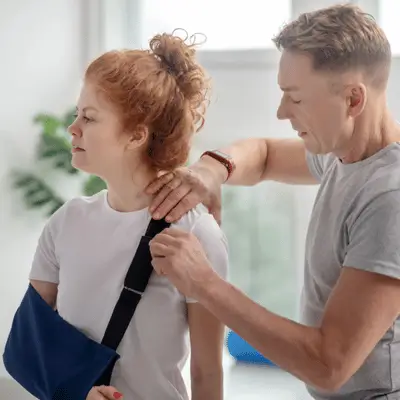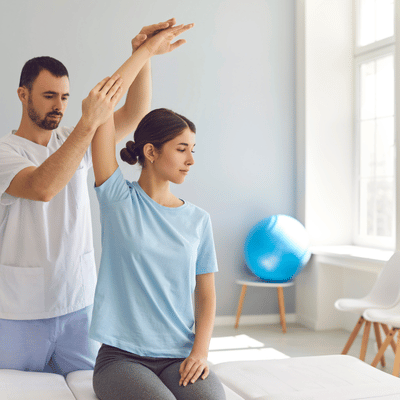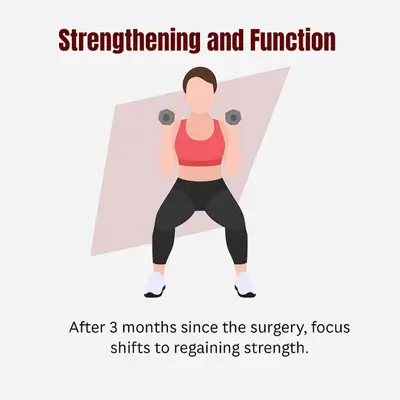Recovering from rotator cuff surgery takes time, patience, and proper care. Your shoulder needs months to heal after a rotator cuff repair that reattaches damaged rotator cuff tendons caused by rotator cuff tears.
This guide offers a general idea of rotator cuff surgery recovery and explains how a physical therapist will progress you through tailored physical therapy milestones. Many patients resume normal activities within four to six months after the surgical intervention, yet a torn rotator cuff can demand extra caution.
Follow your surgeon’s instructions, attend every therapy session, and allow your body to heal so you reach full recovery. With consistent effort, most people regain strength and function after rotator cuff surgery, even when multiple rotator cuff tears required complex rotator cuff surgery techniques.
Understanding Your Rotator Cuff Surgery
The rotator cuff includes four muscles and tendons that connect your upper arm bone to your shoulder blade. These muscles work together to stabilize your shoulder joint and allow smooth arm movement. When you have rotator cuff tears, these tendons get damaged and cause shoulder pain and weakness.
A rotator cuff injury can happen from sports, falls, or wear and tear over time. Some people develop a torn rotator cuff gradually from repetitive overhead motions. Others get hurt suddenly from lifting something heavy or falling on an outstretched arm.
During rotator cuff repair surgery, your surgeon reattaches the torn tendon to your bone using special anchors and sutures. Arthroscopic rotator cuff repair uses small incisions and a tiny camera. This approach often means less discomfort than open surgery and faster initial healing.
The surgery typically takes 1-3 hours depending on the size of your tear. Most repairs are done as outpatient surgery, meaning you go home the same day. Some patients may need general anesthesia while others can have the procedure done with a nerve block.
Your rotator cuff tendons need six to eight weeks to start healing properly to the bone. During this healing period, the repair is fragile. Moving too much too soon can cause re tearing. This is why following restrictions is so important.
Recovery time varies by person. Factors like tear size, tissue quality, age, and how well you follow your physical therapy regimen all matter. Some people feel good at four months after surgery. Others need closer to a year for full strength. Large tears or revision surgeries may take longer to heal properly.
First Week After Surgery: Protection and Rest

The first few weeks after surgery focus on protecting your repair and managing pain through physical therapy. You’ll go home the same day as your surgical procedure in most cases. Having someone drive you home and help you for the first day or two is important.
Pain management is crucial early on. Your doctor will prescribe medications to help control discomfort. If you had a nerve block during surgery, your arm may feel numb for 6-12 hours. Start taking oral pain medicine before the block wears off to stay ahead of the pain.
Different people respond to pain differently. Some need stronger medications for several weeks after the surgery, while others can switch to over-the-counter options sooner. Take medications as directed and don’t try to tough it out. Good pain control helps you sleep better and do your exercises.
Use ice packs wrapped in a thin cloth for 10-20 minutes every 1-2 hours while awake. This helps reduce swelling and reduce pain. Never put ice directly on your skin as this can cause frostbite. A bag of frozen peas wrapped in a towel works well.
Keep your arm in the sling at all times except for specific exercises or hygiene. The sling protects your repair from sudden movements and supports the weight of your arm. You’ll wear it for about 4-6 weeks after cuff surgery. Some people need it longer depending on their tear size.
Proper incision care prevents infection. Keep your incisions clean and dry. For arthroscopic surgery, you typically have 3-4 small incisions covered with bandages. You can usually shower after 48-72 hours if approved by your doctor. Keep the incisions covered with waterproof bandages during showers.
Watch for signs of infection after the surgery like redness, warmth, increased pain, drainage, or fever above 101°F. These symptoms need immediate medical attention. Most infections are rare but can be serious if they develop.
Sleep propped up rather than flat. Use a recliner or pillows to elevate your upper body. Place a small pillow behind your elbow for support. Avoid sleeping on your surgical side.
During this first week, avoid any exercises with your shoulder joint affected by surgery. You can wiggle your fingers and bend your elbow with the sling loosened. Some doctors allow gentle pendulum exercises where you let your arm hang and make small circles.
Weeks 2-6: Gentle Movement Begins

Around two weeks after rotator cuff surgery your rehabilitation truly begins with gentle passive movements. At this stage the repaired tendon should rest, yet the joint needs gentle movement from prescribed exercises to avoid stiffness that could lengthen overall recovery time. Your doctor usually sends you to a physical therapist who guides passive exercises while your shoulder muscles stay relaxed.
Pendulum swings are often first. You lean forward, let gravity take over, and allow the arm that had surgery to trace small circles. Assisted elevation comes next: use the opposite hand or a table to lift the operated arm slowly so the healing tissue does not strain or tear. External rotation with a stick helps maintain flexibility; keep the elbow tucked at your side so the glenohumeral joint stays aligned.
Continue wearing the sling between sessions. Do not add extra sets thinking faster effort fixes a rotator cuff injury. Overloading too soon risks a partial or complete tear that may need another surgery. Light daily tasks such as walking are fine as long as the sling protects the shoulder.
Pain should ease every few days. Mild soreness is acceptable, but sharp or sudden pain is a warning. Stop immediately and call your doctor. If swelling, redness, or fever appears after surgery, your doctor must reassess the rotator cuff surgery site to prevent complications and keep you on track for full function after rotator cuff surgery.
Weeks 6-12: Building Active Movement
Around the 6-week mark after the surgery, many patients can stop using the sling if healing looks good. Your surgeon will check your progress and clear you for active exercises. Now you start moving your arm using your own muscle power.
Your shoulder will feel weak after being in the sling for a long time since the surgery. Start with arm movement without weight. Practice lifting your arm forward and to the side within comfortable ranges.
Active exercises might include finger walks up the wall to gently reach overhead. You can also do isometric exercises where you contract muscles without moving the joint. Press your hand against a wall in different directions to engage your rotator cuff safely.
Continue stretching to regain your full range of motion. Work on forward, side, and rotational movements. Internal rotation (reaching behind your back) often takes longest to return.
You can resume more daily activities like dressing, eating, and light housework. Still avoid heavy lifting or sudden movements. Most people with a desk job can return to work during this phase.
Months 3-6: Strengthening and Function

After 3 months since the surgery, focus shifts to regaining strength. Your therapist adds resistance using bands, light weights, or machines. Start with 1-2 pounds and build slowly.
Strengthening exercises target your rotator cuff and shoulder muscles. External rotation with bands works the back of your cuff. Internal rotation strengthens the front. Shoulder blade squeezes improve stability.
You can gradually return to more activities during this phase. Light lifting, household chores, and gentle sports movements become possible. Slowly increase your activity level to avoid setbacks.
Contact sports and heavy lifting still wait until later. Most people need 4-6 months before returning to demanding activities. Your surgeon will clear you based on strength tests and possibly imaging.
By 6 months, most patients feel much stronger and can do most everyday activities without limits. However, it’s normal for strength to keep improving for up to a year.
Home Recovery Tips for Success
Success depends on following your plan consistently. Perform exercises daily as instructed. Consistency matters more than intensity. Skipping exercises can lead to stiffness and slower recovery.
Avoid heavy lifting and overhead reaching until cleared by your doctor. Even if you feel good, your tendon needs time to fully heal. Rushing back too soon risks tearing again. Most doctors restrict lifting to no more than a coffee cup for the first month.
Use ice after activities if you have swelling or soreness. Take pain medications as prescribed, especially early on. Good pain control helps you do therapy activities and sleep better at night.
Keep your incisions clean and watch for infection signs. Avoid smoking, which slows healing by reducing blood flow to tissues. Eat well and stay hydrated to support your body’s repair process.
Organize your home for one-armed living. Keep frequently used items within easy reach at waist level. Prepare meals ahead or arrange for help with cooking and cleaning.
Consider getting help with daily tasks like that involve lifting. Having support reduces stress and lets you focus on healing.
Stay connected with your healthcare team. Ask questions if you’re unsure about activities. It’s better to check than risk a setback.
Set realistic expectations for your recovery timeline. Some days will feel better than others. Progress isn’t always linear. Celebrate small wins like sleeping through the night or reaching a little higher than last week.
Stay active in ways that don’t stress your shoulder. Daily activities like walking is excellent for circulation and overall health. Avoid activities that could cause falls or sudden shoulder movements.
Warning Signs to Watch For

Contact your doctor right away if severe pain cannot be controlled with medication, infection signs appear, movement you had gained vanishes, or the hand and upper arm change color or feel numb.
A pop in the shoulder with sharp pain may mean re-tearing after rotator cuff surgery; see your surgeon without delay. Follow-up visits vary based on rotator cuff surgery recovery goals, but typical checkpoints at two and six weeks, three months, and six months track recovery time.
Whether you underwent arthroscopy or open surgery, successful rotator cuff surgery outcomes depend on strict physical therapy for several months. Planning before rotator cuff surgery, guidance during rotator cuff surgery, and monitoring following rotator cuff surgery appointments work together to heal rotator cuff tears through effective surgical repair.
Your Path to Full Recovery
Rotator cuff surgery can dramatically improve your shoulder function and eliminate pain. The key is patience during the recovery period. Each phase brings you closer to your goal.
Protect your shoulder early, work on movement next, then build strength gradually. This process can’t be rushed, but your dedication to physical therapy and home care makes all the difference.
Most patients who follow their plan achieve excellent results. You can return to work, sports, and activities you enjoy. The months of recovery effort pay off with a strong, pain-free shoulder.
Start your recovery journey with confidence. Follow your medical team’s guidance, stay consistent with workouts, and be patient with the process. Your shoulder will thank you with years of improved function and comfort.
Ready to take the next step in your recovery? Contact our experienced physical therapy team today to create your personalized rehabilitation plan and get back to the activities you love.

